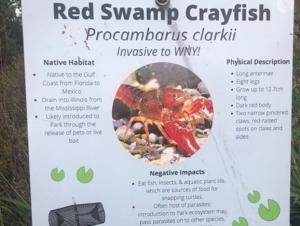

written by Emily Klimczak
Invasive species are a major threat to many ecosystems around the world, including in our own backyards. One such case is the occurrence of the red swamp crayfish (Procambarus clarkii) at the Park School in Amherst, NY. This species was first collected at the Park School by a student in 2020 and since then researchers have been working hard to manage the population size and potential spread of this non-native crayfish. Emily Klimczak, a graduate student, along with her advisor Dr. Chris Pennuto, are currently working on ways to manage this invasive crayfish at the Park School.
Emily, with the help from undergraduate assistant Nick Hahn, has been trapping red swamp crayfish over the summer and will continue her efforts into the fall. This past summer Emily has caught over 800 crayfish! Since its initial finding, nearly 1,200 red swap crayfish have been removed from the pond. While multiple trapping efforts have occurred since 2020, this year saw those trapping efforts nearly tripled over previous seasons. There are traps spread out over the pond, the stream leading to the pond, and the wetland behind the pond. Over the summer, the traps were set 5 days a week. As a comparison, last summer the team caught around 300 crayfish with fewer traps set and over a shorter duration of time. Trapping activities do seem to be having a desired impact of reducing the population size. Summer 2023 resulted in 1.00 crayfish captured per trap night whereas summer 2022 had 1.17 animals collected per trap night.
The increased trapping effort has resulted in an unexpected positive outcome in the Park School ecosystem – the finding of native species! While only a few native crayfish have been found so far, this is a win for researchers as these are the first native species to be seen in the pond since the first red swamp crayfish was spotted in 2020. To date, two native species have been collected at the site. These species include the white river crayfish (Procambarus acutus) and the calico crayfish (Faxonius immunis). Since hundreds of red swamp crayfish were removed from the pond, this could open some room for native species to work their way back into the ecosystem. With intense trapping still happening, there is hope that more native crayfish will start showing up at the Park School.
Image caption: A sign informing visitors of the presence of red swamp crayfish at the Park School.
Some content on this page is saved in PDF format. To view these files, download Adobe Acrobat Reader free. If you are having trouble reading a document, request an accessible copy of the PDF or Word Document.
